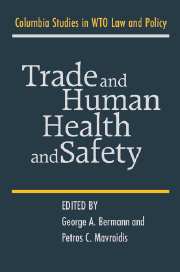Book contents
- Frontmatter
- Contents
- Preface to the Series
- Introductory Remarks
- 1 A Map of the World Trade Organization Law of Domestic Regulation of Goods
- 2 The WTO Impact on Internal Regulations: A Case Study of the Canada–EC Asbestos Dispute
- 3 Reflections on the Appellate Body Decision in the Hormones Case and the Meaning of the SPS Agreement
- 4 The Salmon Case: Evolution of Balancing Mechanisms for Non-Trade Values in WTO
- 5 Lotus Eaters: Reflections on the Varietals Dispute, the SPS Agreement and WTO Dispute Resolution
- 6 Regulatory Purpose and “Like Products” in Article III:4 of the GATT (with Additional Remarks on Article III:2)
- 7 The WTO Standard of Review in Health and Safety Disputes
- 8 Expert Advice in WTO Dispute Settlement
- 9 Domestic Regulation, Sovereignty and Scientific Evidence Requirements: A Pessimistic View
- 10 Time for a United Nations' “Global Compact” for Integrating Human Rights into the Law of Worldwide Organizations: Lessons from European Integration Law for Global Integration Law
- Index
1 - A Map of the World Trade Organization Law of Domestic Regulation of Goods
Published online by Cambridge University Press: 27 July 2009
- Frontmatter
- Contents
- Preface to the Series
- Introductory Remarks
- 1 A Map of the World Trade Organization Law of Domestic Regulation of Goods
- 2 The WTO Impact on Internal Regulations: A Case Study of the Canada–EC Asbestos Dispute
- 3 Reflections on the Appellate Body Decision in the Hormones Case and the Meaning of the SPS Agreement
- 4 The Salmon Case: Evolution of Balancing Mechanisms for Non-Trade Values in WTO
- 5 Lotus Eaters: Reflections on the Varietals Dispute, the SPS Agreement and WTO Dispute Resolution
- 6 Regulatory Purpose and “Like Products” in Article III:4 of the GATT (with Additional Remarks on Article III:2)
- 7 The WTO Standard of Review in Health and Safety Disputes
- 8 Expert Advice in WTO Dispute Settlement
- 9 Domestic Regulation, Sovereignty and Scientific Evidence Requirements: A Pessimistic View
- 10 Time for a United Nations' “Global Compact” for Integrating Human Rights into the Law of Worldwide Organizations: Lessons from European Integration Law for Global Integration Law
- Index
Summary
The Technical Barriers to Trade Agreement, the Sanitary and Phytosanitary Measures Agreement and the General Agreement on Tariffs and Trade
Introduction
Free trade and regulatory autonomy are often at odds with one another. National measures of an importing state may impose costs on international trade, for example, by regulating goods in ways that vary from home market regulation. National measures may restrict market access of imported goods but may or may not be intended to act as protectionist measures favouring domestic industry to the detriment of imports. At the same time, domestic regulation may protect important values. The distinction between a protectionist measure – condemned for imposing discriminatory or unjustifiable costs – and a non-protectionist measure – restricting trade incidentally (and thus imposing some costs) – is difficult to make.
The search for the right balance between disciplining protectionist measures and allowing Member states to maintain regulatory autonomy has characterized the evolution of the General Agreement on Tariffs and Trade (GATT) rules – namely Articles I, III, XI and XX of GATT; the Technical Barriers to Trade Agreement (TBT) and the Sanitary and Phytosanitary Measures Agreement (SPS). This chapter compares the disciplines on domestic regulation contained in each of these agreements, and provides an analysis of the conditions for application of each agreement and the possibility for overlap and conflict among these agreements.
Although the Marrakesh Agreement Establishing the World Trade Organization (WTO) and its annexes (WTO Agreement) is today a single treaty, its provisions were originally negotiated through fifteen different working groups, which may not have been sufficiently co-ordinated with one another.
- Type
- Chapter
- Information
- Trade and Human Health and Safety , pp. 9 - 76Publisher: Cambridge University PressPrint publication year: 2006
- 3
- Cited by



